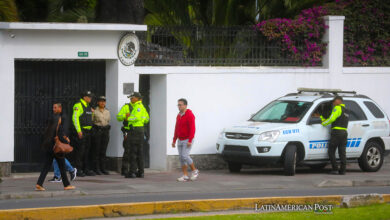Will A European Union Be Possible In Latin America?
The Dream Of Many Integrationists Was Once Again A Topic At the Last CELAC Summit. Why Is A European Union So Difficult In Latin America?.

At the recent CELAC summit, several Latin American leaders again referred to the lack of integration in the region. Photo: TW-lopezobrador_
LatinAmerican Post | Santiago Gómez Hernández
Listen to this article
Leer en español: ¿Será posible una Unión Europea en Latinoamérica?
At the recent CELAC summit, several Latin American leaders again referred to the lack of integration in the region. With several countries that speak the same language or a similar one (Brazil), the absence of institutions of real integration is striking, in comparison with Europe and the European Union.
Precisely, the host president of CELAC; Andrés Manuel López Obrador, again brought up a recurring theme: why is Latin America unable to build something similar to the European Union? The answer is complicated.
En la VI Cumbre de la Comunidad de Estados Latinoamericanos y Caribeños (CELAC) propusimos fomentar la integración de América a partir de la autodeterminación de los pueblos, la cooperación para el desarrollo y la ayuda mutua. pic.twitter.com/KnxTh8sNui
— Andrés Manuel (@lopezobrador_) September 18, 2021
First, it should be noted that in the region, there are subregional integration organizations. However, almost all of these have failed to a greater or lesser extent and many of these are completely delegitimized.
The Andean Community
One of these integration organizations that already exists in the region. It is made up of Colombia, Peru, Ecuador and Bolivia. Previously, Venezuela was part of the group, but under the government of Hugo Chávez as a protest to the FTAs between Colombia and Peru with the United States, it decided to leave and enter Mercosur.
Among the integration elements, there is a free market between the countries for products originating within the zone. Likewise, there is also free movement and citizens of any of these countries do not need a passport to travel within them. There is also an Andean court of justice and agreements on energy, telecommunications, risk and disaster management, and SMEs.
Also read: AMLO Helps Break The Diplomatic Siege Against Maduro
However, the crisis of the group lies in the ignorance of the citizens of these policies and benefits. There is no real integration and the political differences of the countries have demonstrated the instability of the group. Héctor Helí Rojas Jiménez, * Master in Analysis of Contemporary International and Economic Political Problems, explained in an article published by the Sergio Arboleda University that the presidents' lack of will is the basis of the group's crisis.
Mercosur
It is perhaps one of the most successful integration groups in the region. It is made up of Brazil, Argentina, Uruguay, Paraguay and Venezuela (the latter sanctioned by the democratic and political crisis). In addition to having the two main South American economies, it is one of the most stable organizations. However, in times of political differences within the group, there have been blockages in common policies, especially in the signing of free trade agreements. There is an interest from Bolivia to join the economic group.
Currently, the citizens of the member countries have a common market, free movement, the same car license plate, a dispute resolution system, among other elements.
Pacific alliance
It is one of the most recent integration organizations. It is made up of Mexico, Colombia, Peru and Chile. In theory, it is one of the organizations with the most political cohesion, however, with the arrivals of AMLO and Pedro Castillo to Mexico and Peru, respectively, the differences between national interests may affect this union.
Among the results of this alliance, there is an embassy shared by Mexico, Chile, Peru and Colombia in Ghana; a common one between Chile and Colombia in Algeria and Morocco; one between Colombia and Peru in Vietnam. The organization has an Integrated Market of the Stock Exchanges (between Chile, Peru and Colombia), there is ease of student mobility, a tourist visa and a cooperation fund are not necessary.
There is also an interest from Costa Rica, Ecuador, Guatemala and Panama to be part of the group. However, to join the group, you have to have trade agreements with each of the member countries, something that has made it difficult for several of the applicants to enter.
There are other groups, blocs or integration bodies, but their result is similar: a promise of union in theory, but a lack of will in practice. And despite the fact that the speeches in CELAC have coincided in fostering a Latin American bloc, the political and economic differences of the countries are the main obstacle.
The European Union has shown us that the coalition and the union of the group are difficult to keep. Forming an organism with such integration must have, primarily, political stability, continuous governments in all countries. With Brexit, we realized that political groups can create a separatist political flag.
One of the keys to success is the euro. Having a single currency helps the free exchange of goods and services between countries. This implies a renunciation of internal monetary policies and handing them over to a body similar to the European Bank in the control and exchange of the currency. Countries like Venezuela, Ecuador and Panama already do it implicitly or explicitly with the dollar, but having the same exchange policy for Uruguay or Bolivia, as for Brazil or Mexico, would be unbalanced.
Speaking of the economy, for true and real integration, economies must be stable, something that does not happen in Latin America. Today we see in Venezuela, Argentina, Colombia, among others, clear examples of fragile economies that, with their collapse, could lead to the collapse of the entire group.



